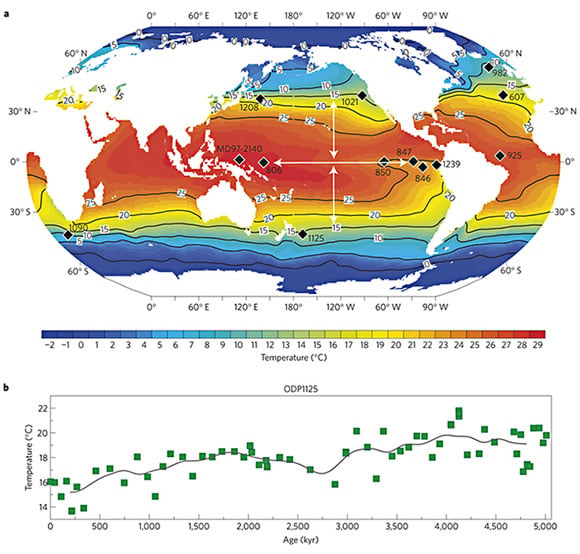
In a newly published study, scientists from Yale University detail the differences in ocean temperatures over the last 5 million years by creating a historical record for sea temperature gradients and comparing it with state-of-the-art climate model simulations.
The study is published in the journal Nature Geoscience.
Sea temperature gradients (contrasts) in the tropics and subtropics are the engines of Earth’s climate. They control global atmospheric circulations, as well as the transport of water vapor for the planet.
As part of the study, the researchers investigated climate evolution since the early Pliocene epoch, 4 to 5 million years ago. They looked at the development of gradients along the equator and mid-latitude regions to the north and south.
The early Pliocene was the last time atmospheric carbon dioxide concentrations were as high as today’s levels, yet ocean temperatures during the Pliocene — from the subtropics to the Artic — were much warmer than today. The tropical Pacific, for example, had conditions resembling a modern El Niño that persisted for thousands of years.
“The puzzle is how to explain this warmth during the Pliocene,” said lead author Alexey Fedorov, a professor of geology and geophysics at Yale. “Ocean temperature contrasts are a major part of this puzzle.”
As part of their work, the researchers developed a temperature record for the mid-latitude South Pacific, where there had been no long-term temperature record. The new data shows that water temperatures during the Pliocene were about 5 degrees Celsius (9 degrees Fahrenheit) warmer than today.
“It has been argued that temperature contrasts were weaker during the Pliocene, implying a weaker atmospheric circulation,” Fedorov said. “In our study, we confirm the reduced contrasts and show a tight link between ocean east-west (equatorial) and north-south (equator to mid-latitudes) temperature variations.”
Co-authors of the study are Natalie Burls of George Mason University (formerly a postdoctoral researcher at Yale), Kira Lawrence of Lafayette College, and Laura Peterson of Luther College.
The U.S. Department of Energy Office of Science, the National Science Foundation, the National Oceanic and Atmospheric Administration, and the David and Lucile Packard Foundation supported the research.
Reference: “Tightly linked zonal and meridional sea surface temperature gradients over the past five million years” by Alexey V. Fedorov, Natalie J. Burls, Kira T. Lawrence and Laura C. Peterson, 16 November 2015, Nature Geoscience.
DOI: 10.1038/ngeo2577
2 Comments
The hardest part? Was training all the volunteers to survive in the various conditions of the last five million years before they were loaded into the time machine.
Here’s a thought… What if the oceans actually are a major factor in climate and the atmosphere is mostly just the means of transporting vapor inland, that expands and deepens when the oceans are warm because the same amount of sunshine provides a greater volume of water vapor. Then we might also see that glacier formation and ice ages are actually a result of too much warming of the seas, and that the excess heat is converted to kinetic energy and stored in inland fresh water resources as kinetic potential. And then the energy in running water and glaciers is actually not free energy, but has a source.